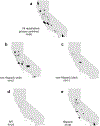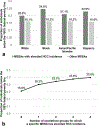Disparities in hepatocellular carcinoma incidence by race/ethnicity and geographic area in California: Implications for prevention
- PMID: 30113700
- PMCID: PMC6436543
- DOI: 10.1002/cncr.31598
Disparities in hepatocellular carcinoma incidence by race/ethnicity and geographic area in California: Implications for prevention
Abstract
Background: The incidence of hepatocellular carcinoma (HCC) has been rising rapidly in the United States. California is an ethnically diverse state with the largest number of incident HCC cases in the country. Characterizing HCC disparities in California may inform priorities for HCC prevention.
Methods: By using data from the Surveillance, Epidemiology, and End Results 18-Registry Database and the California Cancer Registry, age-adjusted HCC incidence in California from 2009 through 2013 was calculated by race/ethnicity and neighborhood ethnic enclave status. A geographic analysis was conducted using Medical Service Study Areas (MSSAs) as the geographic unit, and race/ethnicity-specific standardized incidence ratios (SIRs) were calculated to identify MSSAs with higher-than-expected HCC incidence compared with the statewide average.
Results: During 2009 through 2013, the age-adjusted incidence of HCC in California was the highest in Asians/Pacific Islanders (APIs) and Hispanics (>100% higher than whites), especially those living in more ethnic neighborhoods (20%-30% higher than less ethnic neighborhoods). Of the 542 MSSAs statewide, 42 had elevated HCC incidence (SIR ≥ 1.5; lower bound of 95% confidence interval > 1) for whites, 14 for blacks, 24 for APIs, and 36 for Hispanics. These MSSAs have 24% to 52% higher proportions of individuals below the 100% federal poverty line than other MSSAs.
Conclusions: APIs and Hispanics residing in more ethnic neighborhoods and individuals residing in lower income neighborhoods require more extensive preventive efforts tailored toward their unique risk factor profiles. The current race/ethnicity-specific geographic analysis can be extended to other states to inform priorities for HCC targeted prevention at the subcounty level, eventually reducing HCC burden in the country.
Keywords: cancer registry; geographic analysis; hepatocellular carcinoma; racial disparity; targeted prevention.
© 2018 American Cancer Society.
Conflict of interest statement
CONFLICT OF INTEREST DISCLOSURES
The authors made no disclosures.
Figures



References
-
- Ferlay J, Soerjomataram I, Ervik M, et al. GLOBOCAN 2012 v1.0, Cancer Incidence and Mortality Worldwide: IARC CancerBase No. 11 [Internet]. Lyon, France: International Agency for Research on Cancer; 2013. Available at: http://globocan.iarc.fr/. Accessed July 23, 2015.
-
- Islami F, Miller KD, Siegel RL, Fedewa SA, Ward EM, Jemal A. Disparities in liver cancer occurrence in the United States by race/ ethnicity and state. CA Cancer J Clin. 2017;67:273–289. - PubMed
Publication types
MeSH terms
Grants and funding
LinkOut - more resources
Full Text Sources
Other Literature Sources
Medical

